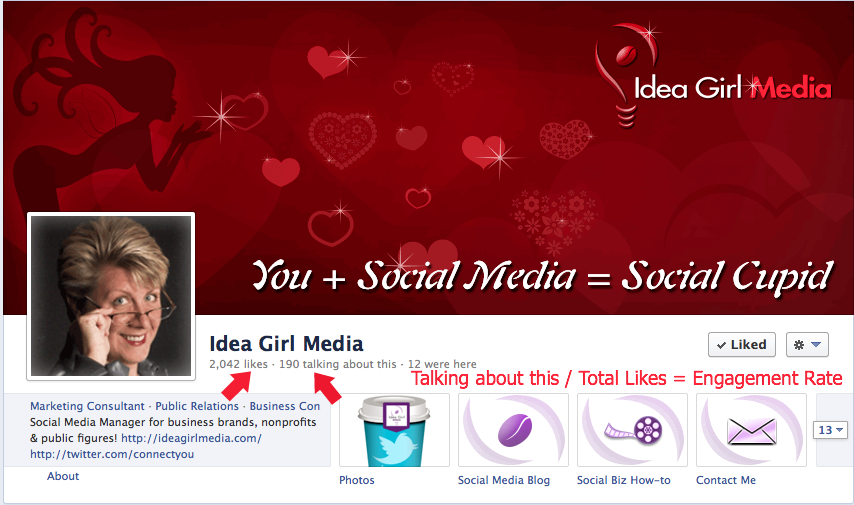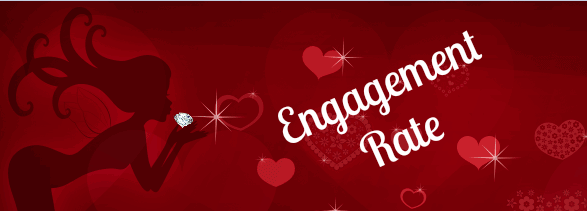Many Facebook Page Admins are not sure at first which metrics are important on a Facebook Page. Here, discover why understanding engagement rate is more important than People Talking About This (PTAT).
You mean, it’s about more than just People Talking About This (PTAT) on Facebook?

PTAT is not a full-color number
If you’re a smart Facebook marketer, it should be. A good idea to become more familiar with Engagement Rate…
People Talking About This On Facebook
When Facebook first released the “People Talking About This” (PTAT) metric, it was met with positive feedback because it was a quick-glance route to knowing more about a Facebook Page. Many thought you could gauge:
- Fan base interaction with the brand.
- Page Admin interaction with the fan base.
- Performance level of Page Admins.
For instance, if you strolled by a Facebook Page and saw a large number of fans, but only 3 people talking about it, the red flags would indicate that the fan base is not very passionate about the brand.
It was right about this time that discussions of Pages purchasing fans heated up. Some believed the PTAT number would reveal culprits with low levels of conversation on-page.
While the Talking About This metric is a quick way for potential fans to determine if they want to click like, and for page owners to check up on Page Admins, considering only this number leaves one with only half the story.
What contributes to the ‘People Talking About This’ number?
Despite your inclination to think so, it’s not just the number of fans commenting on a Facebook Page. The PTAT number increases when someone does:
- like a page.
- post on the page wall.
- like a post.
- comment on a post.
- share a post.
- answer a question.
- RSVP to a page’s event.
- mention the page in a post.
- tag the page in a photo.
- check in at a place.
- share a check-in deal.
- like a check-in deal.
- write a recommendation.
- claim an offer.
Not so simple, eh? Now consider that each post tracks it’s own PTAT. Too much, too quick? Inside Facebook offers a more detailed People Talking About This definition for those wishing to drill down.
If you look at that list above, some of it is NOT directly related to interaction on the Facebook page itself. A few things to consider:
- Just because someone Liked the page, does not mean they are interacting yet or talking about it.
- The PTAT number reflects engagement for the past week. But the visible numbers shown are a few days behind.
- Also included in the PTAT number are interactions from promoted posts and ads.
So, this number can be manipulated and gamed, as pointed out by socialbakers.
Perhaps a better metric to consider is…engagement rate.
Engagement Rate Definition
A Facebook Page’s Engagement Rate is a percentage of the number of fans (likes) Page Admins have attracted to the page and enticed to interact.
You can actually calculate “Daily Page Engagement Rate.” There’s a really groovy algebraic formula for that. Again, for those that like working numbers.
So, small business owners and entrepreneurs, how about a more simple view, eh?

Idea Girl Media Facebook Page, mid-February 2013
Pictured above, the essential numbers to look at are highlighted.
The simple math:
190 (PTAT) divided by 2042 (total number of likes) = .093046 or…
9.3% Engagement Rate.
This provides a quick estimation and a more realistic view of what is really happening on the page.
What Is A Good Engagement Rate On Facebook?
We had been hearing from some social media thought leaders that 1-2% was the average.
But a closer look at thousands of Facebook Pages indicated that the range is more accurately .5 to 1%.
So, while my average engagement rate floats between 12-20%, and I was feeling a bit low over the 9.3% for the day noted above, it is still considered a decent number. It tells visitors to the page that fans are interacting, and there is effort being given to nurture relationships with fans.
Which is really what having presence on a Facebook Page is all about!
Put A Ring On It
We can look at analytics, do math, and configure all sorts of percentages, but a good Facebook Page Admin knows when things are not going well on their page.
They are looking at interactions on a “per post” basis:
- Likes.
- Comments.
- Shares.
And also trends for groupings of posts. They will constantly be examining what fans are interacting with, how, and when, and looking for ways to optimize efforts in response to that.
The most accurate look at what’s happening on a Facebook Page is engagement rate. Social media presence including more than one social network can then be evaluated with similar data.
Engage Me
Does this post help you understand engagement rates on Facebook?
What questions do you have about increasing your Facebook Page’s engagement rate?
Please post your questions or feel free to share your favorite engagement tips below in comments! 🙂


